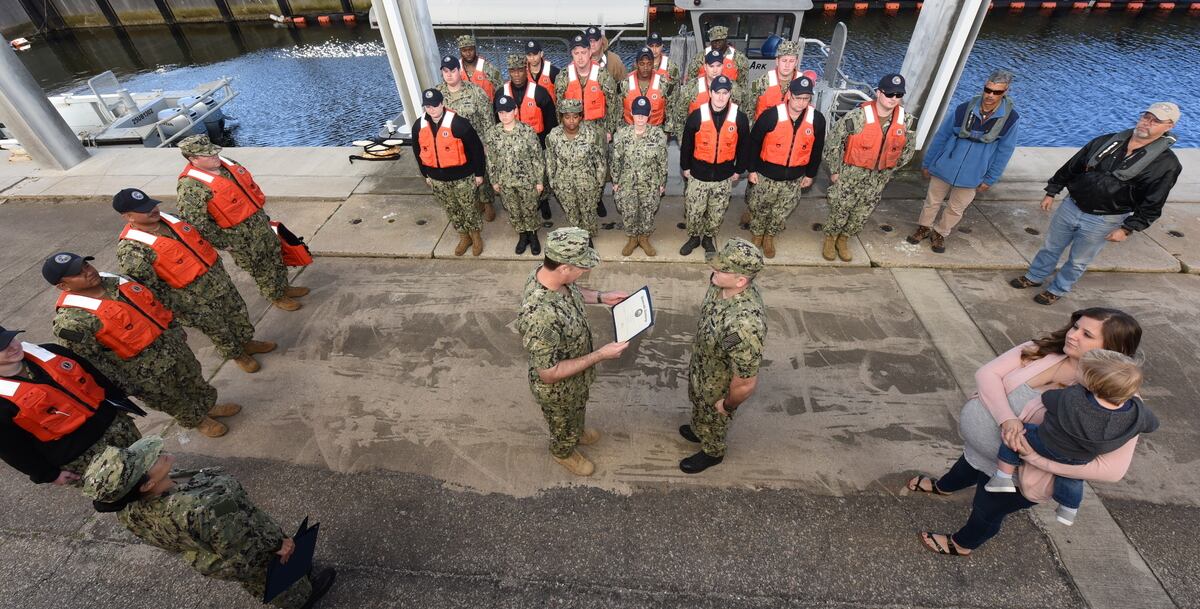In the face of a booming economy, the Navy kept about 74 percent of its enlistment eligible sailors during fiscal 2019, figures released by the sea service earlier this month show.
Sailors in their first decade of service, which includes two “zones” — A, which covers years one through six and B, covering years six through 10 — reenlisted at rates of 64 and 72 percent respectively.
The service had set a benchmark of 57 percent for Zone A and 67 percent for Zone B.
Sailors in Zone C, or those with 10-14 years of service, reenlisted at 85 percent, above the service’s benchmark of 82 percent.
An administrative message declared the latest numbers prove sailors “are proudly declaring that the Navy remains their employer of choice.”
RELATED

The recent annual figures are slightly down from last year’s numbers, when 78 percent of those who were retention eligible stayed in uniform.
Fleet Master Chief Wes Koshoffer said the slight decline stemmed from policy changes during previous years that hiked retention, such as reforms to high-year tenure and physical readiness assessments.
“We no longer had that residual effect of the policy change so we think this is more akin to what our natural retention would be as seeking to be an employer of choice in the global job market here,” he said.
He said that’s why the Navy isn’t “declaring this year as that much more remarkable."
With the U.S. unemployment rate hovering around its lowest in decades — at 3.5 percent in December according to the U.S. Bureau of Labor Statistics — the Navy has relied on targeted incentives, including selective bonuses, to retain top talent, plus new initiatives under Sailor 2025 intended to offer sailors and their families more transparency and flexibility over their careers.
Koshoffer said it remains much more cost effective to retain an experienced sailor than it is to recruit and train a new one.
RELATED

Still, some rates remain a challenge.
“If you want to know where we are most challenged, you follow the money to the highest bonuses,” Koshoffer said in an interview earlier this week.
Those ratings include special warfare operators, nuclear operators and sailors who specialize in cryptologic computer networks.
“There’s just a massive growing job market in cyber with huge salaries starting and otherwise. It’s just an incredibly vibrant and growing market,” Koshoffer said. “There’s opportunity everywhere in cyber.”
The Navy will continue to grow throughout Fiscal Year 2020 and the sea service has set aggressive retention goals to meet its expanding manpower needs.
Benchmark retention goals for Zones A and B are 57 percent and 67 percent, respectively. Zone C is listed at 82 percent.
It won’t be a hard sell to Yeoman 2nd Class Thomas Mahoney, 26, who’s been in the Navy for five years and is preparing for his second reenlistment.
He joined the sea service after working in high-end restaurants, where he said he fought for shifts while attending community college.
“The Navy provides a streamlined structure, transparent expectations and a fair wage for wherever you’re at and whatever you’re doing,” he said. “What’s making me stay in is, what other job in the world is going to pay you to do 20 years and retire after 20 years and then give you the experience for the work force if you choose to get out and get another job, you know, the background for it?”
Courtney Mabeus-Brown is the senior reporter at Air Force Times. She is an award-winning journalist who previously covered the military for Navy Times and The Virginian-Pilot in Norfolk, Va., where she first set foot on an aircraft carrier. Her work has also appeared in The New York Times, The Washington Post, Foreign Policy and more.




